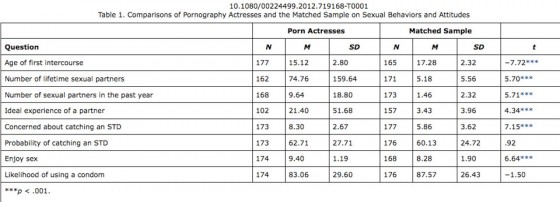
One night a few years ago, I sat across the table from a crying woman—a porn actress— at L.A.’s Genghis Cohen restaurant. She had just undergone an attack interview on her hometown TV station.
“When I say that I had a happy childhood,” she said, “they always act like I’m lying.”
A recently-released study published in the Journal of Sex Research might help to deflate some persistent beliefs about the women who appear in porn films: it turns out that—for the most part—they’re just like you.
“Pornography Actresses: An Assessment of the Damaged Goods Hypothesis” (2012, James D. Griffith, Sharon Mitchell, Christian L. Hart, Lea T. Adams, and Lucy L. Gua) is a paper based on answers supplied by 177 pornstresses and a matching sample of non-pornogamous women. Each of the porn actresses was a client of Adult Industry Medical (AIM), the de facto Porn Valley STD testing facility until it was forced to close in 2011. One of the study’s authors is Sharon Mitchell, founder and executive director of AIM and a former porn actress herself.
The women used in the matching sample were rounded up, the paper reports, from universities and airports.
The findings might come as a shock to the sweeps week news crew that terrorized my date. Answering the same list of questions as the airport/university crowd, porn actresses were in fact found to have higher self esteem, experience more sexual satisfaction, be more inclined to spirituality, and be more satisfied with their quality of life than their non-porn counterparts.
The only significant deviations between porn and non-porn respondents were in average number of lifetime sexual partners (74 for porn women, five for civilians) and drug use (pornstresses tried way more drugs). Porn performers were also more likely to lose their virginity at 15, a full two (but not three) years before members of the matching sample group. “Barely Legal” would be scandalized.

But the study did not find evidence that women in porn were more likely victims of Childhood Sexual Abuse (CSA) than women who didn’t grow up to be adult actresses. This blows to hell the popular narrative.
But media reports of this study tend to blow the CSA factoid out of proportion. The study’s authors acknowledge the difficulty previous researchers (Andrea Dworkin, Gail Dines, Catharine MacKinnon, Susan Faludi, et al) had in securing porn performer participation and are justifiably proud of the massive sample Mitchell and AIM provided (porn respondents were enticed with a chance to win $300 in STD tests from AIM), but they still acknowledge the CSA issue requires more research:
MacKinnon (1993) claimed that all pornography actresses were victims of CSA, although she had no empirical data to support her assertion. It is possible, however, that self-reports of individuals regarding CSA in the pornography industry may have been different 20 years ago when MacKinnon offered her opinion. Based on indications from a single question about CSA, there was no evidence that porn actresses had higher levels of exposure than other women. However, as the measure was superficial (or limited), the conclusions are therefore tentative and further research is required.
In an instance of science imitating porn, the AIM group provided fodder for not one but three separate papers. Mitchell’s data was the source of two other recent studies published in the International Journal of Sexual Health, “A Comparison of Sexual Behaviors and Attitudes, Self-esteem, Quality of Life, and Drug Use among Pornography Actors and a Matched Sample” and “Why Become a Pornography Actress?”
It’s like when a woman shoots a scene for “Avatar XXX” and it is recompiled for “Military Babes,” “Barely Legal in Space,” and “Blue Girls with Big Tits.”
While I believe the environment in which porn actresses took the survey may have played a larger role in their answers (pleasant AIM office with the hope of $300 in tests vs. an airport, for example) than the authors care to admit, that the study’s Los Angeles-centric sample missed the very different San Francisco porn scene, and while I can point to many pornstresses’ Twitter streams as evidence of delusional thinking and inflated self-esteem, I also believe that comprehensive surveys like this one are more often cited than read, so its mere presence is a good thing for perception of the adult industry and the women in it.
Previously on Porn Valley Observed: Lorelei Lee writes about porn for a bigger screen; Study determines why only evil clowns get laid; The Pain of “The Price of Pleasure”; CatalystCon—in the room with sex workers and elephants; Satine Phoenix sends a birthday message to an abusive father; Set to screen—”The Truth About O”
See also: Pornography Actresses: An Assessment of the Damaged Goods Hypothesis

I am not really a pornstar, but I do make porn, and I am not damaged goods either, and I get tired of people assuming I am. Most of the people I’ve met who make porn seem like pretty happy, non-crazy women, too! Thanks for posting this–I am going to spread it all over the place! 🙂
~Riko